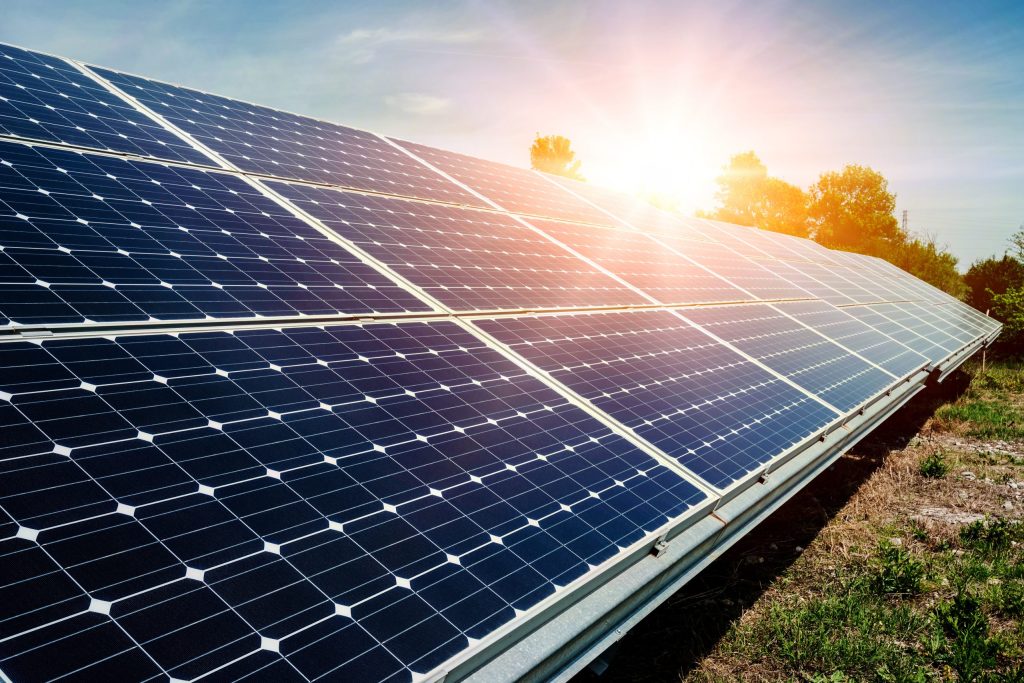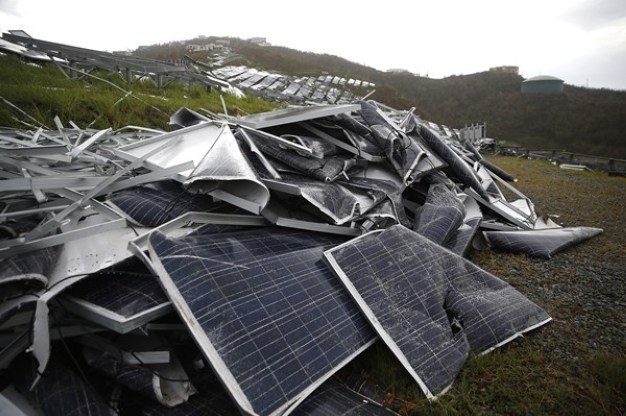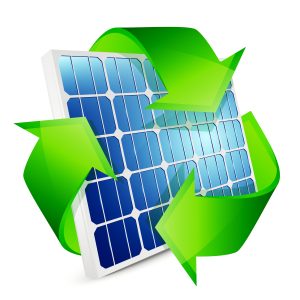The Death of a Solar Panel
By Alicja Mazurkiewicz, 2021-2022 Environmental Leader
Solar panels. They are often the first thing that comes to mind when we hear the words “renewable energy.” They capture the energy of the sun’s rays and convert it into electricity and heat. Solar energy usage in the United States has increased by 42% in the past ten years, and is only expected to grow further (Solar Industry). But, how “renewable” are the solar panels themselves? It is important to examine what happens to solar panels at the end of their lifespan to reveal some of their possible adverse environmental effects.
 Image: Shutterstock
Image: Shutterstock
To understand the life and death of a solar panel, we should first take a look at what solar panels are made of. The most popular type is called a crystalline silicon panel; its main component that captures the sun’s energy – the solar cell – is made of silicon. According to IRENA, the average silicon solar panel today is “76% glass (panel surface), 10% polymer (encapsulant and backsheet foil), 8% aluminum (mostly the frame), 5% silicon (solar cells), 1% copper (interconnectors) and less than 0.1% silver (contact lines) and other metals (mostly tin and lead)” (End-of-life). Other components that don’t make up the panel itself, include inverters, racking, and battery backup systems.

Image: Katja Volk
The average functional lifespan of a solar panel is about 25-30 years, so clearly they don’t last forever! In 2016, there was up to 250,000 tons of solar panel waste; however, by 2050 this is expected to jump exponentially to 60 and 78 million tons per year! (End-of-life) These estimates don’t take into account the fact that solar panels may be replaced before they reach their end of life in 30 years. Newer silicon panels are 20%-25% efficient than previous models but each year the efficiency of a panel drops by 0.5% due to solar cells denigrating from continual sun exposure (How long). So, after 25-30 years, the panel doesn’t really “die,” rather its energy output dips far below the intended output, making the option of installing newer panels a more cost effective option.
Yet, the sheer amount of waste piling up in landfills isn’t the only issue. Another consideration is the mass and volume percentage of different types of materials in a solar panel; these materials are hazardous or non-hazardous. 66% of the world’s solar panels are silicon based, and of these, 90% of their combined mass consists of glass, polymer and aluminum, all of which can are classified as non-hazardous waste (End-of-life). However, solar panels do contain hazardous material, like trace amounts of cadmium and lead. Solar cells leach these harmful substances into surrounding water and soil when they are disposed of, and contamination poses a risk to human and environmental health.

Image: Jessica Rinaldi
Existing recycling processes, typically carried out at regular recycling centers, can aid in recycling components of solar panels. Glass recycling is already well established; the aluminum frame, and copper wire are also recyclable. The other components of a solar power system: inverters, racking, and battery backup systems, also have systems in place to be recycled. However, it is still difficult to recycle some materials including silicon, silver, internal copper, and trace amounts of lead, tin, and cadmium: the materials that pose the greatest environmental and health risks. Unfortunately, while there are some recycling opportunities for solar panels, according to the Harvard Business Review, it costs an estimated $20-30 to recycle one panel, wheas discarding that same panel in landfill would cost just $1-2 (Atasu). But, this is only the direct cost. Solar panels are different from other types of glass, or metal waste; they are delicate yet bulky. Because they are specially installed in large quantities on the roofs of homes and commercial or industrial buildings, they require specialized labor to remove, transportation to recycling facilities, and individual separation of layers (Atasu). Further, because of the trace amounts of toxic metals in solar panels, in some areas they are considered hazardous waste, which requires specific recycling and transportation processes, which only add on to the cost (Atasu).

Image: Shutterstock
Reusing solar panels is another option, even though it has not yet been widely implemented. Even though solar panels’ efficiency decreases over time, this doesn’t mean that they should be completely thrown away. Old solar panels could be used to power homes or other buildings with lower energy needs, or they could have applications outside of the main electrical grid, like electric car or bike charging stations.
The US does not currently regulate panel disposal, meaning that most end up in landfills. Even in the state of Maryland, in 2020 a bipartisan bill that would have minimized the release of hazardous substances and maximize recovery of materials and recycling of collected used solar panels, did not pass (Solar Photovoltaic). But this could change! Just 20 years ago, solar panels were almost nowhere to be seen, and now, partly thanks to the Solar Tax Credit, more homeowners and businesses are harnessing the power of solar. Solar panel recycling and reuse is gaining traction – the solar panel recycling market is expected to grow to about $480 billion, by 2030: an increase of 13% from 2020 (Allied). However, policies that force or incentivise solar panel recycling or reuse – like the bill in Maryland – are necessary to avoid those 78 million tons of landfill waste.
Solar panels are paving the way for renewable energy. However, homeowners and business owners should be aware of the risks of solar panel disposal and strongly consider solar panel recycling pathways to avoid contributing to dangerous waste.
Works Cited
Allied Market Research. www.alliedmarketresearch.com/solar-panel-recycling-market-A14237#:~:text=Solar%20Panel%20Recycling%20Market%20Outlook,13.1%25%20from%202021%20to%202030. Accessed 7 Feb. 2022.
Atasu, Atalay, et al. “The Dark Side of Solar Power.” Harvard Business Review, 18 June 2021, hbr.org/2021/06/the-dark-side-of-solar-power.
End-of-life Management: Solar Photovoltaic Panels. June 2016. International Renewable Energy Agency, www.irena.org/publications/2016/Jun/End-of-life-management-Solar-Photovoltaic-Panels
“How long do solar panels last? Solar panel lifespan explained.” Energy Sage, news.energysage.com/how-long-do-solar-panels-last/. Accessed 7 Feb. 2022.
“Solar Industry Research Data.” Solar Energy Industries Association, www.seia.org/solar-industry-research-data. Accessed 7 Feb. 2022.
Solar Photovoltaic Module Recycling: A Survey of U.S. Policies and Initiatives. U.S. Solar Photovoltaic Module Recycling: A Survey of U.S. Policies and Initiatives, Mar. 2021. National Renewable Energy Laboratory, www.nrel.gov/docs/fy21osti/74124.pdf.
About the Author:
 Alicja Mazurkiewicz, 2021-2022 Environmental Leader
Alicja Mazurkiewicz, 2021-2022 Environmental Leader
Alicja is a sophomore at Holton-Arms School. Her passion lies in identifying and implementing approaches to preserve the health of the environment against the threats of rising pollution and climate change.





